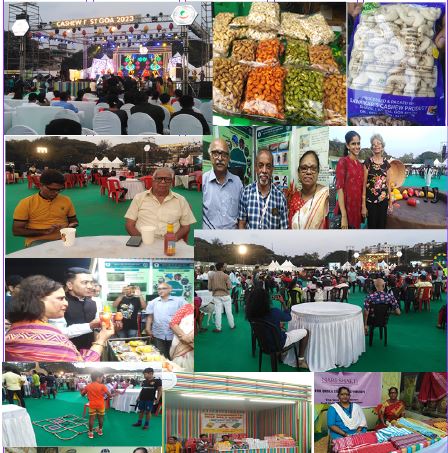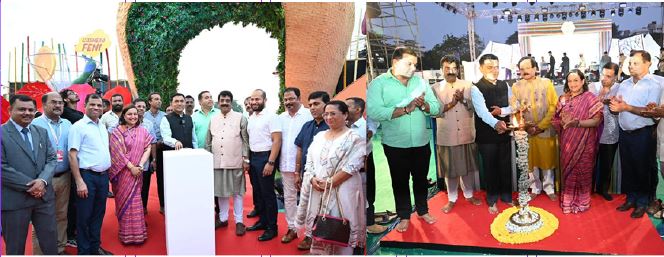CASHEW FESTIVAL 2023: Lighting the ceremonial lamp and taking a bow for the organisation of this reportedly first ever event to celebrate Goa’s cashew business is Poriem MLA Deviya Rane (in pink saree). Congratulating for her for the achievement are amongst other dignitaries are Chief Minister Dr Pramod Sawant who inaugurated the fest on April 15 in the presence of Minister for Tourism, Ports, Shipping & Waterways of India Shripad Naik, Minister for Health & Forests Vishwajit Rane, Sadanand Shet Tanawade (chairperson EDC), Minister for Tourism Rohan Khaunte, Dr Deviya Rane (chairperson, GFDC), Rohit Monserrate (mayor–CCP), Rajiv Kumar Gupta (IFS, Principal Chief Conservator of Forests)and several officials and staff of the GFDC.
By Tara Narayan
IT is a question which arose in my mind while taking in the paisa feko tamasha dekho sights of the first ever Cashew Festival of Goa at the green and red carpeted Campal parade grounds in capital city over the weekend of April 15-16, 2023. Of course, who doesn’t love caju or cashew nuts, especially in Goa, a state now promoting cashew nuts and related products like the GI-tagged State liquor feni (or fenny, I prefer fenny)?
But the sad truth is that the caju business is a dying business and it has always been a khaas aadmi business – only rich Goans eat caju day in and day out (including Municipal corporators during their meetings)! For the aam aadmi caju remains by and large …a no no. They may be promoting cashews of Goa at the festival but the various stalls were selling caju at Rs500 to Rs1,000 kg plus, plus, all depending on their quality of course. The wild grown caju of Goa enjoy a reputation a cut above all other caju of the country or the world.
What the glamorous Minister of Forests says about caju being a way of life in Goa is true but then again caju is a way of life for the rich classes…in poorer Goan homes one would be lucky if caju tukda find themselves in the odd dessert for a special occasion! But then it is not caju or cashew nuts one is referring to here now…at one time caju was a way of life in Goa when the bhatkar ruled the roost and there were any number of munkars working on their vast lands of paddy and fruit orchards.
When the colonial time Portuguese first transplanted the caju tree from its native Brazil to Goa – the beautiful low-growing tree caju took root happily and as one of the learned speakers at the technical sessions at the Cashew Festival said – the tree has found a home over four and five generations and is now native to Goa! A cashew tree orchard makes for a lovely picture when the cashew apples grow and acquire their exquisite amazing colouring of warm matt yellow to warm red rose …indeed, it is as if they are lit up “lamps” lighting up the gloom of the orchard. At the end of each cashew apple is the greyish “nut” which we call caju or the cashew nut which has to be removed and set aside for roasting and extracting “nut” within during the harvesting stages and processing of the season’s cashew apple fruit.
THERE is so much to the fruit and cashew tree. It spawned an entire spectrum of life and living for the local people – traditionally, the cashew apples were picked up or harvested only once they dropped to the ground, that’s when they offered up the gift of flavorful sweetness. Cashew apples were washed, a trampled upon by labour with special long boots, the aromatic juice of the cashew apple collected and the last of the niro or neero juice runs clean and delicious – this is the piece de resistance fresh drink, drink it on the rocks in 24 hours or stock up to a week in the fridge.
Cashew apple niro or neero is a thirst-quenching drink like no other and naturally a very “nutrilicious” drink. Neero I love to drink whenever I can find it during the short cashew season from March to May in Goa! At one time it was considered of no use and actually given away free to anyone who wanted it I am told. Here I am referring to the clear last flow of the cashew apple juice when it turns clear as crystal water – the first collection of juice is fermented in a tank before is it goes into traditional terracotta or now copper distillers, for distilling into urrack first — agreeably alcoholic. It’s the second distillation which yields the pure liquor of feni or fenny (which over the years has acquired a heritage liquor of the state of Goa tag and is now also GI or geographically indexed).

This is to say over time imbibing both urrack and feni became a way of life and became more or less every native and migrant (?) worker’s favourite tipple or spirit to warm up the cockles of the heart – be it by the roadside, beachside, in the local gloomy tavern for the working class, or the privileged non-working bhatkar or landlord class who drank and served the best of their orchard lands’ seasonal neero, urrack and feni in grand family casa or showpiece ancestral homes.
THEN we come to the cashew “nuts” (or the nut in the cashew apple’s seed) which are detached painstakingly from each cashew apple and the dried out greyish oval or oblong nuts sand or drum roasted — to arrive as pinkish skinned kernals where the skins may be easily rubbed off. Or further processing techniques may arrive at the matt or glossy ivory white kernals which we see more commonly in the market caju shops – some say buy the drum roasted cashew nuts with their pink papery skins on for they are more delicious in flavour! Most prefer to buy thoroughly cleaned out cashew nuts which may come in various sizes from pygmy to jumbo size. Remember big is not necessarily tastier.
CULINARY FAVOURITE
THERE are several takes on cashew nuts with the fresh tender cashew “biyo” also playing a culinary role in traditional Goan dishes…at the Cashew Fest several stalls offered cashew “biyo” and green pea xacuti along with cashew pulao, and all manner of other cashew based dishes. Cashew nuts in pieces or grated or powder form go into cakes, pastries, all kinds of confectionary and from the O’Coqueiro stall I bought savoury “caju rissois” for Rs250 (got about six or seven rissois, the puffy crescents were miserly with their stuffing of cashew nut mixture with much of the fried savoury hollow! No value for money or hunger at all.
A lot of stuff was for sale at the Cashew Festival of course (see photo essay elsewhere here)…with a meal deal of veg or non-veg going for Rs300/Rs350/Rs400, most dishes incorporating the caju nut copiously or not so copiously. Food was too expensive so I just stuck to my favourite drink of fresh neero (cashew apple juice) which was being offered infused with a bunch of mint leaves and lemon juice at one of the stalls, priced Rs100 and very refreshing. Second evening at the festival at the same stall I asked why the neero was pinkish today and the guy here replied, “Today’s neero is pasteurized neero!” (Well, I thought, better pasteurized neero than pasteurized, toned, double-toned, homogenized dairy milk!)
ACTUALLY, it was amazing to see quite a few have put out “neero” enshrined drinks in the market now in proper pet bottles, to mention one of them Goan Fest’s “Cashew Apple Delight” was introduced at the festival and which everyone who got a free promotional bottle took a shine too – it reminded me of syrupy “Mangola” of one time, if you remember, is it still in the market? Pet bottle ingredients lists “cashew apple juice (27%)” and the rest is the usual water, sugar, edible common salt, acidity regulator, preservative, INS…the 200ml bottle advice is “Best served chilled.” Preferably on the icy rocks…nice, but at the market price of Rs50? Only the government can afford to buy it. Khaas aadmi, far too health-conscious, prefers to drink only imported mineral water from Europe or actual mineral or volcanic water from the mountains of the Himalaya or the hills of India…bottled in glass bottles!
(Sigh) The bottom-line is nobody is really interested in genuine health-consciousness or being eco-friendly from A to Z. As a civilisation we are becoming sick human beings and along with this we are losing our marbles too…everybody is playing amassing more money games including the government of the day. Not news anymore. Think about all this and don’t sit on the fence if you love Mother Earth who makes all life on earth possible.
POSTSCRIPT: The Cashew Festival for all its entertainment value raised one question. Why does the government powers-that-be think of promoting an expensive nut and a liquor distilled from its fruit – instead of the humble kokum – a native fruit of the Konkan coast and far more loved by Goans, more affordable too! A state level kokum festival would be very welcome as long as kokum doesn’t become as high end as caju. Someone please the idea of a Kokum Festival next into Poriem MLA Divya Rane’s head!
